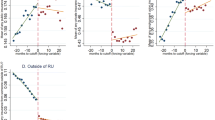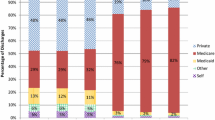Abstract
We investigate the impact of losing health insurance coverage at age 26 due to aging out of the Affordable Care Act’s dependent coverage on health insurance coverage rates and various indicators of inpatient medical care. We find that the probability of being covered under any type of health insurance plan decreases by 2.5–6.2 percentage points at age 26. However, the effects of this discrete change in health insurance coverage on inpatient medical care and related costs are insignificant.

Similar content being viewed by others
Notes
In terms of methodology, this paper is also similar to few recent papers that focus on the pre-ACA period. Before the ACA’s dependent coverage mandate was enforced, many private health insurance contracts covered dependents through age 19 or 23 if they are a full time student. Using a RD design, few studies find that health insurance coverage rates among young adults exhibited a discrete change at these cutoff ages (Anderson et al. 2012, 2014; Cardella and Depew 2014; Yörük 2016, 2017).
We cannot use the waves before 2011 since the ACA was introduced on September, 2010. Until 2012, the MEPS reported beginning and ending date of each hospital stay (including day, month, and year). Based on this information, we were able to compute the exact number of days in each month that an individual had stayed in a hospital. Starting from 2013, the MEPS only reports the month and year of inpatient stays’ beginning date and ending date. Without information on the exact day, we do not have enough information to calculate the length of stay and expenditure associated with it. Thus, our analysis on inpatient stays uses data from 2011 and 2012.
Since information on the exact birth date is not available, it is not possible to determine the exact date of turning 26 for each respondent. Therefore, it is impossible to determine the treatment status of a respondent for the month that she turns 26. In order to address this problem, we exclude the month that each respondent turns 26 from the sample.
Using the event files of the HC of the MEPS, we calculate the exact number of days in each month that an individual stayed in a hospital. If the individual reports multiple inpatient stays at a given month or if the stay spans to multiple months, we calculate the total charge, payment, and out of pocket costs based on the total number of stays in a given month. For instance, if a patient reports two separate stays within the same month, we add up the spending from each stay in order to find the total spending in that particular month. Alternatively, if the stay spans multiple months, we calculate the spending for each month based on the number of days of stay for each particular month.
It is also possible to estimate similar non-parametric RD models. The results from these models are comparable to those from the parametric models. The results from the non-parametric models are not reported due to space constraints but are available from the authors upon request.
Total charge, total payment and out-of-pocket cost tend to be skewed and results might be sensitive to functional form assumption. To address this possibility, we estimate alternative RD models for the log transformation of these variables (we add 1 to each variable before transformation). The results remain statistically insignificant for total charge and total payments. We find a relatively small and marginal significant impact for out-of-pocket costs, but this effect disappears with relatively smaller age bandwidths. We thank an anonymous referee for pointing this suggestion.
References
Anderson, M., Dobkin, C., & Gross, T. (2012). The effect of health insurance coverage on the use of medical services. American Economic Journal: Economic Policy, 4, 1–27.
Anderson, M., Dobkin, C., & Gross, T. (2014). The effect of health insurance on emergency department visits: Evidence from an age-based eligibility threshold. Review of Economics and Statistics, 96, 189–195.
Akosa Antwi, Y., Moriya, A., & Simon, K. (2013). Effects of federal policy to insure young adults: Evidence from the 2010 Affordable Care Act’s dependent-coverage mandate. American Economic Journal: Economic Policy, 5, 1–28.
Akosa Antwi, Y., Moriya, A., & Simon, K. (2015). Access to health insurance and the use of inpatient care: Evidence from the Affordable Care Act young adult mandate. Journal of Health Economics, 39, 171–187.
Barbaresco, S., Courtemanche, C. J., & Qi, Y. (2015). Impacts of the affordable care act dependent coverage provision on health-related outcomes of young adults. Journal of Health Economics, 40, 54–68.
Cardella, E., & Depew, B. (2014). The effect of health insurance coverage on the reported health of young adults. Economics Letters, 124, 406–410.
Cattaneo, M. D., Titiunik, R., & Vazquez-Bare, G. (2019). Power calculations for regression discontinuity designs. Stata Journal, 19, 210–245.
Cantor, J. C., Monheit, A. C., DeLia, D., & Llyod, K. (2012). Early impact of the Affordable Care Act on health insurance coverage of young adults. Health Services Research, 47, 1773–1798.
Chua, K. P., & Sommers, B. D. (2014). Changes in health and medical spending among young adults under health reform. Journal of the American Medical Association, 311, 2437–2439.
Dahlen, H. M. (2015). “Aging out” of dependent coverage and the effects on US labor market and health insurance choices. American Journal of Public Health, 105, 640–650.
Dillender, M. (2015). The effect of health insurance on workers’ compensation filing: Evidence from the affordable care act’s age-based threshold for dependent coverage. Journal of Health Economics, 43, 204–228.
Imbens, G., & Lemieux, T. (2008). Regression discontinuity designs: A guide to practice. Journal of Econometrics, 142, 615–635.
Kolstad, J. T., & Kowalski, A. E. (2012). The impact of health care reform on hospital and preventive care: Evidence from Massachusetts. Journal of Public Economics, 96, 909–929.
Lee, D. S., & Lemieux, T. (2010). Regression discontinuity designs in economics. Journal of Economic Literature, 48, 281–355.
Sommers, B. D., Buchmueller, T., Decker, S. L., Carey, C., & Kronick, R. (2013). The Affordable Care Act had led to significant gains in health insurance and access to health care for young adults. Health Affairs, 32, 165–174.
Sommers, B. D., & Kronick, R. (2012). The Affordable Care Act and insurance coverage for young adults. Journal of the American Medical Association, 307, 913–914.
Yörük, B. K. (2016). Health insurance coverage and self-reported health: New estimates from the NLSY97. International Journal of Health Economics and Management, 16, 285–295.
Yörük, B. K. (2017). Health insurance coverage and risky health behaviors among young adults, B.E. Journal of Economic Analysis and Policy, 17, 1–21.
Yörük, B. K. (2018). Health insurance coverage and health care utilization: Evidence from the Affordable Care Act’s dependent coverage mandate. Forum for Health Economics and Policy, 21, 1–24.
Yörük, B. K., & Xu, L. (2019). Impact of the ACA’s dependent coverage mandate on health insurance and labor market outcomes among young adults: Evidence from regression discontinuity design. Eastern Economic Journal, 45, 58–86.
Author information
Authors and Affiliations
Corresponding author
Additional information
Publisher's Note
Springer Nature remains neutral with regard to jurisdictional claims in published maps and institutional affiliations.
Rights and permissions
About this article
Cite this article
Nguyen, T.T., Yörük, B.K. Aging out of dependent coverage and the effects on the use of inpatient medical care. Int J Health Econ Manag. 20, 381–390 (2020). https://doi.org/10.1007/s10754-020-09285-z
Received:
Accepted:
Published:
Issue Date:
DOI: https://doi.org/10.1007/s10754-020-09285-z




